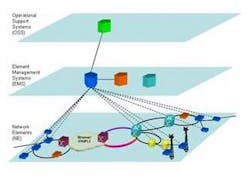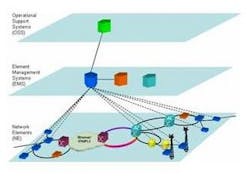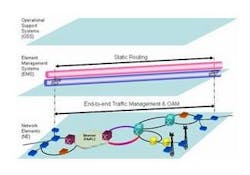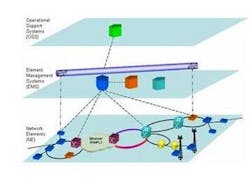Ethernet eats everything
Improvements to Ethernet technology -- including intelligent tunnels, end-to-end traffic management, and greater resiliency to hard and soft failures -- promise to make the protocol better able to replace SONET/SDH. Connection-oriented Ethernet platforms that support today's standards (PWE3/MPLS) and are field software upgradeable to emerging standards (PBT and T-MPLS) will provide service providers the flexibility they seek.
By David King
Gridpoint Systems
Ethernet continues to demonstrate its resilience against time, technical, and market limitations. Service providers are making the move to Ethernet to offer enhanced data services and lower capital and operating costs through a converged packet transport fabric.
To meet growing demand and match the capabilities of previous technologies, equipment suppliers and service providers must evolve Ethernet for it to continue to thrive. Carriers are seeking to simplify their networks by converging to a common operations approach that combines the low cost and networking flexibility of packet processing with the determinism; operations, administration, and maintenance (OAM) capabilities; and operational attributes (reliability, quality of service [QoS], and scalability) found in their circuit-based infrastructure. As shown in Figure 1, this approach may span the network element, network element management, and operational support system layers.
Innovations are being introduced at all levels of the network hierarchy. Network-element-based standards are improving Ethernet functionality and interoperability. Element management systems (EMSs) are being introduced that provide comparable capability to previous WAN management platforms and offer "east/west" application-level integration typically through Java-based application programming interfaces. For larger networks, "northbound" EMS interfaces use protocols such as Simple Object Application Protocol (SOAP) to integrate into operational support systems that incorporate a variety of additional functions (service ordering, billing, etc.).
Evolving Ethernet to meet growing demand
Major Ethernet improvements are being implemented to enable and support subscriber growth. As highlighted by the Metro Ethernet Forum (MEF), five key attributes critical to Carrier Ethernet's success are: standardized services, quality of service, reliability, service management, and scalability. Each of these areas is evolving at a pace driven by vendor innovation, standards development, and subscriber growth (Figure 2).
Initial improvements are followed by more advanced features as new innovations are introduced. It is critical that carrier-grade functionality is added to Ethernet equipment without losing the cost-effectiveness and simplicity that make it attractive in the first place. There are several connection-oriented Ethernet approaches emerging that have the promise of meeting this need.
Connection-oriented Ethernet
Connection-oriented Ethernet has the opportunity to provide an operational framework similar to SONET/SDH and may be implemented using present (MPLS and pseudowires) and emerging (PBT and T-MPLS) standards. Which architecture(s) will dominate is a heated debate. Each provides differing levels of functionality and complexity and has support from various equipment suppliers and service providers. While some service providers advocate specific implementations, others are more agnostic, pushing only for the need to meet the MEF attributes at prices and availability which prove in their business cases. In this climate, the most successful vendors to watch will be those that can seamlessly operate in either domain -- pseudowires or PBT -- without adding cost or complexity to the service provider.
Reducing complexity is a common theme, as it directly affects capital and operating costs and improves scalability. Improving service levels will have a direct impact on revenue. A new approach to reducing costs and improving service levels in connection-oriented Ethernet is the deployment of intelligent tunnels.
Intelligent tunnels
In addition to multi-service transport offered by some tunnel implementations, as shown in Figure 3, intelligent tunnels incorporate end-to-end traffic management and OAM to provide resiliency to both hard and soft failures.
Intelligent tunnels may be provisioned statically through a centralized application or dynamically through signaling. Static provisioning has the benefit of adding determinism to Ethernet and reducing the complexity and bandwidth usage of existing distributed routing protocols. Centralized routing algorithms may be used to choose the best path considering multiple constraints. These algorithms ensure QoS parameters (delay, jitter, loss, and availability) for the subscribed bandwidth profile (committed information rate [CIR], excess information rate [EIR], excess burst size [EBS], and committed burst size [CBS]) are met along with specific service provider business rules (cost, load balancing, link traffic preference, etc.).
Static routing eliminates the prospect of the broadcast storms inherent in Ethernet's connectionless behavior. As part of its learning process when a switch receives data en route to an unknown destination, its only option is to "flood" or copy the data to all of its outgoing ports. Eventually the intended destination will be reached via one of the ports and a reply will be returned. This reply is used by each switch to note which specific port corresponds to the destination. While this mechanism was feasible in a LAN environment, it can generate considerable network congestion and security concerns in the WAN. Static routing addresses this concern by introducing deterministic route selection.
Offering advanced QoS
Ethernet service delivery continues to evolve from best-effort services to those offering varying degrees of QoS. Many providers attempt to meet demand for guaranteed Ethernet service levels through severely overprovisioning the network. This overprovisioning becomes unsustainable as the numbers of subscribers grow, as each connection must be allocated bandwidth largely in excess of the CIR, challenging the access network.
Likewise, many desire to offer a range of service classes from best-effort service with no guarantee, to guaranteed contracted bandwidth. Innovative service providers are looking to give preferential access to excess bandwidth to provide further competitive differentiation. To meet these challenges, a shift from local to end-to-end traffic management is required.
Through the use of end-to-end traffic management, intelligent tunnels optimize bandwidth, thus reducing costs and/or enabling additional subscribers. Through congestion avoidance at the edge, only packets that can successfully transit the network to their destination are admitted. In addition, overprovisioning is not required to statistically ensure the CIR is delivered.
To meet service-level agreement (SLA) objectives, sufficient bandwidth needs to be allocated for each service, at each node in the path. The allocation must be based on the bandwidth profile, which includes a CIR, an EIR, and corresponding allowed bursts. Bandwidth allocation must also take into account QoS objectives from the SLA and the specific implementation of each node (e.g., scheduling, buffer size). To account for possible overlap of bursts and guarantee CIR delivery, other tunnel technologies require additional bandwidth to be allocated. The amount required is dependent on the ratio of CIR/EIR and can exceed CIR by up to 600%. Intelligent tunnels can deliver the CIR without the need for additional bandwidth, freeing resources for more customers.
Improving reliability through end-to-end OAM
Many service providers have grown accustomed to OAM functionality from legacy WAN technologies and demand the same from Ethernet. The ability to troubleshoot growing Ethernet networks including the capability to monitor flows, detect and isolate faults, and automatically recover from fault conditions, is critical.
There is significant activity in several standards bodies to improve Ethernet's OAM capabilities. Emerging standards such as IEEE 802.1ag for connectivity fault management and ITU Y.1731 for Ethernet OAM and performance management are being implemented to provide management capabilities across multiple platforms.
In addition, through vendor innovation, more advanced features common in circuit-based networks, such as "bridge and roll," are being introduced. This capability allows a service provider to move services from existing resources (switches or links) easily to conduct maintenance without customer impact. Paths can be tested before they are returned to service, which maximizes uptime, reduces maintenance windows, and minimizes manual effort.
Improvements are being introduced to offer resiliency to hard and soft failures. Some vendors have improved on the benchmark set by SONET/SDH's protection mechanism by offering faster than 50-msec link recovery after a hard failure. In addition, through the use of intelligent tunnels, recovery from soft failures due to network congestion or link impairment is possible, which enables the delivery of resilient SLAs.
Delivering scalable, resilient SLAs in multiple applications
Ethernet is evolving to deliver scalable, resilient SLAs in multiple applications using intelligent tunnels. A variety of architectures have been proposed and deployed to offer Ethernet transport and services in both wireline and wireless applications. Various combinations of Layer 2 switches, switch/routers, and multiservice provisioning platforms (MSPPs) will exist in the core, access, and edge networks (Figure 4).
To meet the growing demand, a variety of new partnerships will emerge. Layer 2 switch vendors will introduce intelligent edge devices and enhance their network EMSs to offer more comprehensive capabilities. Switch/router vendors will introduce additional edge devices with end-to-end traffic management to increase their access reach. MSPP vendors will add packet fabrics by introducing Ethernet to their existing wavelength and sub-wavelength transport capability. Wireless Ethernet vendors will introduce features to reduce the complexity of network deployment and improve their backhaul capability.
Standardization and vendor and service-provider innovation are helping to evolve Ethernet to meet growing demand and ensure Ethernet will indeed eat everything. The recent interest in PBT by BT, Verizon, and Bell Canada sends a strong signal that carriers are looking to connection-oriented Ethernet to help reduce costs and maintain their existing operational approaches when deploying new Ethernet transport and services. Connection-oriented Ethernet platforms that support today's standards (PWE3/MPLS) and are field software upgradeable to emerging standards (PBT and T-MPLS) will provide service providers the flexibility they seek. Intelligent tunnels that combine end-to-end traffic management and OAM will be keys to delivering the scalable, resilient Ethernet SLAs demanded by service providers and their enterprise customers.
David Kingis vice president, marketing and product line management, Gridpoint Systems (www.gridpointsystems.com).




